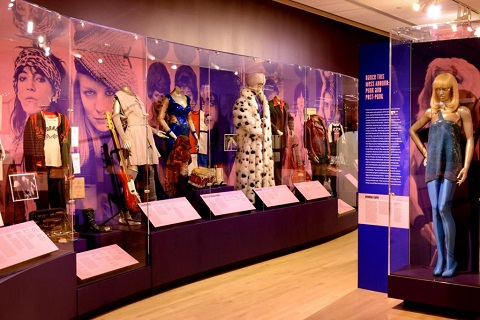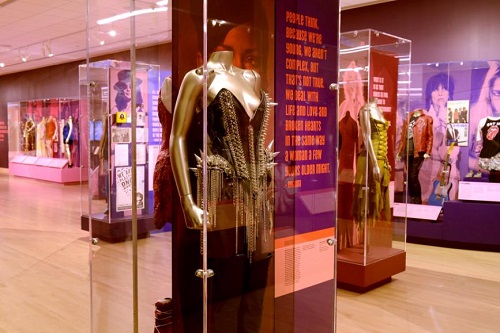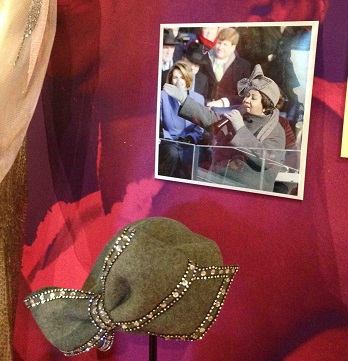
By Janet Traylor/January 22, 2014
“Popular music really functions as the soundtrack to people’s lives in many ways; you attach your memories to it.” Cullen Strawn, curator of the ‘Women Who Rock’ exhibition, Phoenix, Arizona
I set out to test Cullen Strawn’s theory, inviting three music-loving family friends from three different generations to join me to see Women Who Rock, an exhibition at the Musical Instrument Museum (MIM) in Phoenix.

Originally created by the Rock and Roll Hall of Fame and Museum in Cleveland, Ohio in 2010, Women Who Rock showcases the performances, iconic stage outfits, memorabilia and even the instruments of more than 70 women, from Mother Maybelle Carter in the 1920s to Taylor Swift and Lady Gaga, who have played significant roles in rock and roll.
My companions ranged in age from nearly 90 to an 11-year-old: Helen Alderson, born in 1924; Helen’s granddaughter, Michele Hermanson, born in 1967; and Michele’s daughter, Annie Chaves, born in 2002.
We walked through the exhibit, looking at Lady Gaga’s childhood piano, Bonnie Raitt’s custom guitar, the elegant performance dresses of The Supremes, personal diaries and other artifacts that provide a window into the lives and work of these artists. I wondered what music memories were being triggered for my friends and how they were responding.
I asked Helen, “What music did you listen to as a girl in rural Nebraska?”
“Oh, honey, we really didn’t hear much music when I was in elementary school,” she said. “That was during Depression days, and no one had much of anything; music was esentially church hymns.”
Though almost every home had a piano, she said, they didn’t have a phonograph machine to play recordings. To conserve energy, her father, born in the 1890’s, rarely consented to using the battery-powered radio to play music.
“We were not without music, but it was mostly home-made,” remembered Helen. The Big Bands were popular during her high school years, she added. “Music gravitated out from movie stars through the radio and movies, and phonographs swept the country,” she said. “We sometimes bought sheet music at the 10-cent store.”

Although the soundtrack to Helen’s early life was essentially self-made and somewhat limited by circumstances, she enjoyed seeing the exhibition and marveled at the changes in popular music since her girlhood. Case in point was Helen’s great-granddaughter Annie, who adeptly wielded her own fully-loaded iPod, and is definitely a fan of Lady Gaga, along with Christina Aguilera, Rihanna, Taylor Swift and Britney Spears.
To the consternation of her mother, Michele, Annie was attracted to their glitzy, revealing costumes. She made a beeline to Britney’s two-piece gold-sequined halter top and tight, midriff-baring low-rise pants. “I want to wear THAT!” she proclaimed.

Michele remembered listening to punk and British alternative music in her teenage years and a 1990’s song by the group Luscious Jackson about being a woman. The message:
Be who you are; don’t worry about
what society tells you to be.
“I still listen to it,” she said with a smile.
“You can find examples throughout the exhibition of very calculated use of clothing,” Curator Strawn said. The form-fitting, flesh-colored outfit Britney Spears wore at the 2000 MTV music awards when she sang “Oops!…I Did It Again,” he mentioned, was a turning point in Spears’ career. “It was a conscious presentation, and it had the effect of changing her image from a girl to a woman in charge of her sexuality.”

1990/Photo: Janet Traylor
Pop superstar Lady Gaga had strategic aims when she wore her ‘meat dress’ at the 2010 MTV Video Music Awards. Concocted of Argentinean flank steak and preserved hermetically, the outfit looks a little like a pelt that might have graced the figure of a Cro-Magnon woman. According to Strawn, Gaga herself saw it as a political and social statement about human rights.
Madonna, the exhibition signage reminds us, was among the first to take charge of her career and make an enterprise out of her sexuality and physicality. Alongside her revealing costumes, such as her infamous conical bra corset designed by Jean Paul Gaultier, you can see her personal notebook with notations about costs for an appearance and a grocery-shopping list. That list is covered by a sticky note reminding her to contact Mike Myers to prepare for a 1992 appearance on Saturday Night Live.
Curator Strawn sees the theme of empowerment as fundamental to the exhibition. Madonna was only one of the many who kept her own counsel, seized control of her destiny and made it big.

Image Courtesy of Rock and Roll Hall of Fame and Museum
Among other examples, he cited musician Joan Jett, who was also featured in the exhibition. “She exemplifies female musicians who wear not only an artistic hat, but a business hat, taking increased control over the many facets of their careers.”
 Jett was in The Runaways when she was just 15. She wrote songs and was a major presence, but when the group broke up, her work was rejected by no fewer than 23 major record labels. According to Strawn, it was essentially because she was too rock-and-roll–too edgy.
Jett was in The Runaways when she was just 15. She wrote songs and was a major presence, but when the group broke up, her work was rejected by no fewer than 23 major record labels. According to Strawn, it was essentially because she was too rock-and-roll–too edgy.
But Jett persevered. She kept her black leather clothing, including her black leather jacket, which is on display, and harder edge, and resisted any pressure to “pop it up.” She printed her own recordings and sold them herself, eventually evolving into Black Heart Records.
Like Strawn, Michele appreciated Jett’s individuality and lack of conformity. The Mama Cass Elliot and Queen Latifah sections of the exhibition provided Michele with a welcome reminder that talent, hard work and self-determination can supersede dress size and redefine the concept of beauty. “Mama Cass was comfortable in her own skin,” the exhibition text noted alongside her large flowery tent dresses.

Photo: Janet Traylor
Queen Latifah, whose high school yearbook from 1987 and publicity outfit from 1989 are on display, became one of the first female hip-hop musicians to gain international stature. She proved that the world of rap was not the exclusive domain of male artists. Taking control of her career, she went on to achieve seven Grammys, a Golden Globe and an Academy Award.

Seeing Cher’s outlandish costumes in the exhibit was a blast from the past for me, as it would have been for my good friend Ann, Michele’s mother, who passed away unexpectedly more than two decades ago. Ann saw Sonny & Cher when they came to town and was crazy about them. Taking a cue from Cher, Ann even had her own fur vest. Surely Cher was the mother-of-all of the midriff-baring, over-the-top outfits of her era and the years to follow.
Another musician I reconnected with at the exhibition was Aretha Franklin, the first female performer inducted into the Rock and Roll hall of Fame (1987). As one of the best-selling female artists of all time, she charted more Billboard top-40 singles than any other female performer (45 since 1961, as stated in the display).
I enjoyed seeing a replica of the gray wool hat she wore in 2009 on a freezing January day when she performed at the inauguration of President Barack Obama. The plain version retailed for $179. Outlined with Swarovski crystals, the customized version cost $414.90. (The order form, displayed in the exhibition, showed a graceful sketch of the hat, along with a notation of the price.)

and her special hat/Photo: Janet Traylor
The dramatic oversized bow and sparkling crystals made it both jaunty and elegant. Contemplating that hat, and the historic setting in which it made its debut, I thought about how much has changed since Aretha made her first album in 1961, the same decade in which the civil rights movement peaked.
The hat sparked reverie for me, as did so many other items showcased in the exhibition. I thought of Curator Strawn’s comment about popular music being “the soundtrack to people’s lives.” I left the museum with new appreciation for the soundtrack of my own life, and also for those uniquely personal ones of my friends.
To find out more about the artists and where to see this exhibit next, click here.
###




Leave a Reply